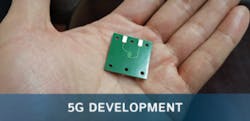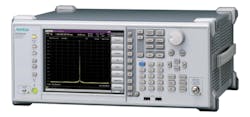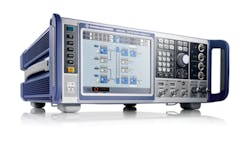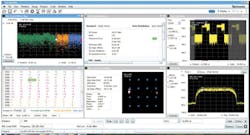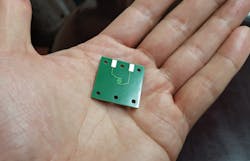This year is shaping up to be a critical one for 5G, as several participants in 5G development have pointed out. Efforts at standardization are continuing as the development of the multiple technologies that might make up 5G proceeds. Other challenges center on frequency allocation and coexistence—with previous generation cellular technologies as well as with radar and satellite signals.
According to James Kimery, director, marketing, RF research/SDR at National Instruments, “2017 will be a pivotal year in the 5G trajectory as the worlds’ telecommunication infrastructure companies, silicon providers, service operators, and test-and-measurement companies finalize the specifications, conduct field trials, and begin the commercialization process.”
“The major challenge facing 5G this year is that the standard will not be defined as a single wireless technology like its predecessors,” said Dr. Li-Ke Huang, research and technology director at Cobham Wireless. “It will, in fact, comprise a number of different services being delivered to the end user across multiple access technologies and multilayer networks. 5G will effectively be a dynamic, coherent, and flexible technological framework—and very different from the previous generations of wireless standards. It will provide a system that leverages a variety of technologies depending on the precise needs of the application, particularly as IoT becomes more prevalent.”
Ken Karnofsky, senior strategist, signal processing applications, MathWorks, said, “In 2017, we expect to see 5G engineers focusing on development of cost-effective massive MIMO and millimeter wave (mmWave) technologies to achieve high throughput with low power consumption, design of new waveforms to achieve greater spectral efficiency, and rapid deployment of radio testbeds and prototypes to field-test these 5G
technologies.”
Reiner Stuhlfauth, technology marketing manager, Rohde & Schwarz, offered a broad look at the topic. “From a global-political perspective, the key challenges in furthering 5G in 2017 are around standardization and frequency allocation,” he said. “From a standardization perspective, a lot of work remains with 3GPP Release 15 throughout 2017 in order to meet the official release of the specification in June 2018. In addition, there are also some discrepancies between the ‘pre-5G’ specifications and trials underway and the 3GPP 5G specifications that need to be resolved.”
Larry Davis, national sales manager, 5G business development, Anritsu U.S., described some specific challenges. “When we talk about 5G, three big technology hurdles often dominate the conversation—low latency of less than 1 ms, high data throughput of greater than 1 Gb/s, and support of massive connectivity to accommodate 50 billion new IoT devices by 2020,” he said.
Kimery at NI explained, “The 3GPP standardization body has defined two phases of 5G standards development, appropriately named Phase 1 and Phase 2. In 2017, the 3GPP will be driving to define the first unified standard for Phase 1.” As this issue went to press in late February, Kimery expected that in March, the 3GPP would kick off the first 5G work item with an expected completion in September 2018. “Although 5G Phase 1 otherwise known as 3GPP Release 15 is expected to complete in 2018, we should get a clear picture of what will be included in the standard throughout 2017 as researchers around the world take on the monumental task of defining and standardizing each component of a new end-to-end network,” he said.
Davis at Anritsu said, “5G’s success will require disruptive technological innovation in nearly all areas of the 4G network”—including the re-engineering of access networks, base stations, and wireline edge and core networks. “It is the scope of the required change—all interdependent upon the innovation of the others—that represents the biggest challenge of 5G,” he added.
“Some chief hurdles associated with 5G, however, are not technological in nature, but more economics driven,” Davis noted. “For example, if microwave and mmWave bands are to become economically viable options versus emerging alternatives like LTE-U/LAA, test and component suppliers across the ecosystem need to address the significant cost issues associated with high-frequency technologies.”
Nearly every participant in the mobile broadband ecosystem, including component and device manufacturers, network equipment manufacturers, wireline and wireless service providers, and applications developers must introduce disruptive new technologies to meet these technical and economic goals, Davis said, adding, “With an unprecedented interdependence, they all collectively play a critical role in not only delivering essential new technologies and capabilities (that is, beam steering and tracking and mmWave radios), but also reducing the overall cost of networks, UEs, and installation and maintenance processes.”
Huang at Cobham Wireless explained, “Taking into consideration the complexity of 5G, this year the industry will have to explore new and more sophisticated testing and validation techniques”—extending from the chipset and radio antenna to the end-to-end network performance. He continued, “Other factors like air-interface architecture and the different frequency bands must be considered, but important emphasis should be placed on validating the user experience when running new applications.”
Huang added, “The industry is keen to make 5G happen as soon as possible, and the only thing which could slow it down is the core technology and development cycle needed to take it from conception to reality. Market creation, the level of investment, and technical direction are all converging and taking shape, so the real challenge for progressing 5G this year will be the compatibility of different sections of the ecosystem.”
Stuhlfauth at Rohde & Schwarz noted that spectrum allocation and usage on a global and regional scale must be considered and consolidated to minimize the complexity of RF front-end designs, signal processing, and so on. “Finally, 5G will coexist with LTE technology for many years to come, with LTE-Advanced coming out with many new and interesting features—for example, NB-IoT [NarrowBand IoT], LTE-V [LTE-Vehicle], LAA [Licensed-Assisted Access], and eMTC [enhanced Machine Type Communication],” he said. “Companies that are involved with the design and production of mobile wireless devices will need to consider how to best optimize their resources to support both technologies moving
forward.”
Karnofsky at MathWorks commented on the role of engineers this year. “In the race to 5G, system engineers and architects must focus on accelerating innovation and minimizing the valuable engineering time spent on programming, debugging, or building hardware realizations of their design ideas,” he said. “This is particularly important when working with fast-changing pre-standardization communication protocols. The tools and workflows must support rapid design iterations and rapid deployment of new algorithms or design changes.”
Karnofsky added, “Massive MIMO and mmWave technologies will drive dramatic changes to the architecture of the radio front end. The expertise required to design the highly integrated 5G radio technology includes RF, antenna, DSP, control logic, hardware, and software—as well as a working knowledge of existing standards. 5G researchers need new methods to verify that components will work together and eliminate the problems that lead to expensive hardware failures and project delays.”
A particular challenge relates to FPGAs. “A significant hurdle for many teams is a lack of experience with FPGA development workflows and RTL implementation of signal-processing and communications algorithms,” Karnofsky said. “For a typical R&D group that consists of engineers with strong signal-processing and algorithm-development backgrounds but relatively little experience with hardware implementation, it is often difficult to implement FPGA-based radio prototypes and testbeds without outside assistance.”
Sourabh Dhillon, who handles corporate development at startup Integra Devices, sees challenges emerging in building out the telecommunications infrastructure that will offer the high frequencies (for example, 28 GHz) necessary to achieve 5G’s promise of high data speed, high capacity, and low latency.
“Solid-state switches and relays used today, because of their small footprint, will be too much of a liability due to linearity and signal-integrity issues at high frequencies and power,” Dhillon said. “Electromechanical relays, although they can handle high power and frequency, are too large and expensive…. Even PCB material becomes a liability as passing high-frequency signals through it will exhibit loss. Thus, a new breed of RF/mmWave components must be developed to support 5G’s new telecommunications infrastructure.”
Dhillon added, “The test and measurement industry will also face challenges in conjunction with 5G. All new products for the 5G marketplace are being designed in the 6 GHz and above range. 6-GHz switch products for test and measurement are way too large and expensive to be practical…. Vendors are looking at using solid-state, pin-diode, and other technologies, but again these possess linearity and signal-integrity dilemmas as the frequency increases.”
5G coexistence
5G coexistence is an area that Keysight Technologies is addressing. “Just a glance at today’s frequency allocations makes it clear that 5G technology will have to fit into crowded, congested, and complex airwaves,” writes Greg Jue, systems engineer, in a Keysight white paper.1 “Even in this cramped space, demand for higher data throughput continues to grow—and this is why researchers continue to look for new ways to use the available spectrum more efficiently with evolutionary and revolutionary signal formats.”
Jue presents several waveform candidates:
- orthogonal frequency-division multiplexing (OFDM), currently used in 4G;
- filter-bank multicarrier (FBMC);
- universal filtered multicarrier (UFMC), also called universal filtered OFDM (UF-OFDM); and
- generalized frequency-division multiplexing (GFDM).
Figure 1 shows a comparison of OFDM (blue traces) with three candidate waveforms, each with two different filter characteristics (green and red traces). In all cases, compared with OFDM the candidate waveforms are likely to provide better results for adjacent users, Jue notes.
Courtesy of Keysight Technologies
To further explore coexistence scenarios, Jue describes a testbed consisting of 89600 VSA software, an N9030B PXA X-Series signal analyzer, SystemVue electronic system-level software with a 5G baseband library (W1906EP) running on a high-performance embedded controller (M9537A) installed in the AXIe chassis (M9505A), and a two-channel M8190A 12-GS/s arbitrary waveform generator.
He goes on to present three case studies: 5G coexisting with legacy wireless signals, 5G coexisting with satellite signals, and LTE coexisting with radar signals.
“As 5G research and development continues to mature, coexistence will be a crucial area of investigation whether the focus is on the interaction between new and legacy waveforms or between commercial and military systems,” he concludes, noting that the testbed approach can be used in an R&D lab before field tests on working systems.
Platform approach
When it comes to specific products for 5G applications, NI employs a platform approach that enables users to use one platform including hardware and software to focus on application areas critical to 5G networks spanning design and test. “Our SDR hardware coupled with LabVIEW system design software and LabVIEW Communications offers the fastest path for researchers to transition from a concept to a real working prototype,” said Kimery. “The faster a concept can be prototyped, the quicker an idea can transition to field trials, standardization, and eventually commercialization. NI has been enabling wireless researchers to achieve the prototyping phase much sooner even though the system challenges that 5G poses are formidable.”
NI’s platform approach enables users to create, for example, channel-sounding systems capable of making measurements in the mmWave and cmWave frequency ranges quickly. “Current approaches using standard test-and-measurement techniques must collect voluminous amounts of data that must be ‘post processed’ to achieve an accurate picture of the channel,” Kimery said. “Harnessing the power of FPGAs and real-time signal processing delivered by LabVIEW and our SDR platforms, researchers can measure results in ‘real time,’ virtually eliminating post processing. Another benefit of this approach is that channel measurements can be made fast—within the coherence time of the channel—which challenges even the most sophisticated test and measurement instrumentation.”
In addition, said Kimery, “SDRs deliver a software-defined approach that maximally leverages current state-of-the-art technologies such as FPGAs, multicore microprocessors, high-level synthesis tools and abstraction, and the latest A/Ds, D/As, and RF ICs. Because of our platform approach, we apply this same approach to 5G test as the products move from prototype to commercialization.”
MIMO application framework
NI has announced several products targeting the 5G application space, including the MIMO application framework for LabVIEW Communications. This fully scalable architecture enables users to prototype multi-antenna systems having from four to 128 elements at 20 MHz of bandwidth. The software includes a mixture of host/multicore microprocessor code as well as FPGA software to facilitate a fully real-time system. Because of the software is delivered in source code, users can start with a fully functional massive MIMO system and then integrate their ideas to observe the results and iterate.
In addition, NI last year announced what Kimery called the world’s first software-defined radio (SDR) for mmWave research, prototyping, and deployment. “The mmWave Transceiver System, or MTS, offers engineers and scientists the first off-the-shelf platform to transition the mmWave research to a working prototype—fast and efficiently,” he said. “There are several challenges with utilizing the mmWave spectrum for communications, such as wider bandwidths to increase data rates and take advantage of the copious spectrum in those bands. NI’s MTS features a real-time SDR capable of transmitting and receiving up to 2 GHz.” The software provided with the MTS is scalable from 1 x 1 SISO to 4 x 4 MIMO. “This approach gives users a big head start as these platform elements do not have to be developed from scratch—ultimately incurring higher costs and long time to results,” Kimery said.
The latest to join the NI SDR portfolio of products are the USRP-2945 quad receiver SDR device (Figure 2) and the USRP-2944 high-performance 2×2 MIMO SDR device, introduced Feb. 21. Both models deliver a new level of performance and capability to the USRP (Universal Software Radio Peripheral) family, the company said.
Courtesy of National Instruments
From algorithm to testbed development
MathWorks addesses a range of 5G research topics, including algorithm development, simulation, and testbed development, according to Karnofsky. “Active research topics being addressed with MathWorks software include evaluation of candidate modulation and coding techniques, antenna array and RF front end design for massive MIMO and mmWave technologies, waveform generation and analysis, and accelerated development of FPGA-based hardware prototypes,” he said.
“MathWorks tools based on MATLAB and Simulink help 5G engineers efficiently explore algorithms and architectures, optimize system performance, identify critical problems in simulation, and automate hardware implementation and testing on COTS or custom hardware,” he said.
“For engineers designing massive MIMO antenna arrays and new RF front-end architectures, Simulink provides multidomain simulation that permits full-system verification of digital, RF, and antenna design,” he added. “Previously, these different domains have been designed separately, using different specialist tools for each component. With MATLAB and Simulink, they can be designed and simulated together, resulting in more accurate results and faster design cycles.” mmWave spectrum analysis
For its part, in February Anritsu introduced the Spectrum Master MS2760A family (see page 18), which Davis called the world’s first ultraportable, mmWave spectrum analyzers. “One of the most exciting and disruptive test solutions for 5G field trials, the MS2760A has models to support the 32-GHz, 44-GHz, 50-GHz, 70-GHz, and 110-GHz frequencies,” he said. “With a price point one-third that of current lab-based solutions being wheeled around many 5G trial deployments today, it addresses the huge need in the field for simple, economical, and untethered mmWave spectrum analysis.”
Anritsu also has introduced new tools to test emerging small-cell synchronous Ethernet technologies, such as SyncE (ITU-T G.826x) and PTP (IEEE 1588 v2), Davis said. “Next-generation wireless networks such as 5G will utilize small cells in heavily congested urban environments, often lacking the line of site necessary for GPS-based network timing,” he said. “Packet-based timing protocols such as Enhanced SyncE and PTP are emerging to provide network synchronization with limited or no GPS clock. With a new PTP module, the Network Master Pro MT1000A supports the max |TE| [maximum absolute time error], cTE [constant time error], and dTE [dynamic time error] metrics, allowing users to conduct accurate time and phase network verification measurements in accordance with the G827x Time Sync standard.”
In addition, Davis said, Anritsu’s MS2840A benchtop vector signal analyzer (Figure 3) provides product designers with a cost-effective platform to address emerging 5G waveforms up to 44.5 GHz. “The MA2806A and MA2808A waveguide mixers, which have superior conversion-loss performance compared to traditional harmonic mixers,” he said, “are uniquely suited to extend the MS2840’s performance up to 90 GHz while the MA2740C and MA2750C external harmonic mixers enable even higher frequency characterization of 5G components and systems up to 325 GHz.”
Courtesy of Anritsu
Stuhlfauth at Rohde & Schwarz pointed out that because the 3GPP specification for 5G has not been finalized, the majority of work today involves investigation and development.
“Rohde & Schwarz provides a wide range of solutions regarding 5G,” he said, including a portfolio of test equipment and solutions covering aspects such as component test, mmWave signal generation and analysis, over-the-air testing, massive MIMO, phased-coherent signal generation and analysis, protocol application analysis, and enhanced security.
He cited several specific products, including the SMW signal generator (Figure 4) with a 40-GHz frequency range and 2-GHz internal bandwidth, the FSW signal analyzer with an 85-GHz frequency range, oscilloscopes with bandwidths to 6 GHz with four-channel support, the ZNBT20 multiport network analyzer allowing real-time true multiport analysis with 16 simultaneous ports going up to 20 GHz, the SZU millimeter-wave upconverter that uses a direct connection to the SMW signal generator for covering the V-band at 60 GHz, and power sensors integrated in a Vivaldi antenna for power measurement in the range from 10 kHz to 75 GHz. Finally, he cited the company’s RF chambers and a near-field over-the-air antenna measurement capability that operates at high speed using a new method of scanning without the need for access to the digital interface.
Courtesy of Rohde & Schwarz
Network development
Cobham Wireless is focusing on facilitating network development as the industry moves toward 5G. “Cobham Wireless has been working with a range of industry groups to provide validation and testing equipment for 5G technologies,” said Huang. The effort addresses issues related to protocols, the air interface and associated devices, and the wide range of use cases 5G is likely to support.
“Cobham Wireless has created 5G testing solutions that support the development of 5G, looking at everything from the chipset and the radio antenna to the end-to-end network performance,” he said, adding that the company supplies the TM500 industry-standard network test system to major infrastructure vendors and operators globally while also working on developing 5G algorithms.
“Many of the applications for 5G are still in the concept phase, and the number of apps and services will increase as developers come up with ideas over the next decade,” Huang added. “Some will be developed for the primary telecoms market supporting core communications services, but many others will be sector-specific, throwing up a variety of new use cases. Having the TM500 testbed in place can enable companies … to accelerate 5G into vertical industries. Creating a test environment that accounts for future networks and technologies is absolutely critical to the success of 5G.”
Physical-layer test
Tektronix with respect to 5G addresses the physical-layer testing of mmWave and wideband wireless links and radios as well as validation of the performance of high-throughput optical backhaul links, according to Chris Loberg, the company’s senior manager for performance instruments marketing. As for specific products, he said, “For mmWave and wideband wireless links, including support for WiGig IEEE 802.11ad development, Tektronix provides transmitter test of 5G wireless signals using the DPO77002SX 70-GHz oscilloscope with SignalVu software for demodulation and spectral analysis.”
In addition, Loberg said, “Tektronix just announced the RSA7100A wideband signal analyzer with up to a 26.5-GHz frequency range and 800-MHz real-time bandwidth. The RSA7100A can trigger on and measure signals of just 700-ns duration in the frequency domain in real time while offering in-depth RF and modulation signal analysis with SignalVu software.”
When asked about unique features of the company’s product offerings, Loberg elaborated on the software (Figure 5): “SignalVu combines the signal-analysis engine of the RSA5000B real-time spectrum analyzer with the powerful triggering capabilities of the industry’s widest bandwidth DPO7000SX oscilloscope series, enabling designers to evaluate complex signals up to 70 GHz without a need for an external downconverter.” SignalVu provides a common platform for wireless signal analysis across multiple technologies and standards such as QAM, he said, adding that the same SignalVu user interface is used across all Tektronix hardware acquisition systems (DPO7000SX oscilloscopes, DPO70000 oscilloscopes, and RSA5100B, RSA500A, RSA600A, RSA306B, and now RSA7100A spectrum analyzers).
Courtesy of Tektronix
SignalVu also can help customers protect their investment in test equipment as the industry evolves toward 5G. “SignalVu is a software platform on which you can add optional applications—for example, you can add functionality to the base spectral analysis such as OFDM demodulation,” Loberg said, thereby providing the capability to perform additional broadband wireless signal validation on the DPO70000SX oscilloscope while retaining the same basic software platform.
Semiconductors for 5G
Thomas Cameron, CTO of the Communications Business Unit, Analog Devices, described his company as “… a leading vendor of analog and RF components which enable the radio heads. Our technologies span the space from bits to antenna—that is, from the digital/analog interface all the way through the RF signal chain.”
Cameron added, “Currently, we are working with our customers to bring 5G to reality in both the sub-6-GHz space as well as at mmWave frequencies. Our technologies, which include a wide range of circuitry design processes and a systems level approach, are supporting many of the 5G prototypes and system demonstrations globally.”
Cameron offered an example. “The AD9371 is a highly integrated, wideband RF transceiver and is a good example of ADI innovation that is necessary for massive MIMO 5G systems in the sub-6-GHz space,” he said. “The AD9371 offers dual-channel transmitters and receivers, integrated synthesizers, and digital-signal-processing functions. The combination of high performance and low power consumption provided by the AD9371 is key to enabling the massive MIMO form factor.”
Cameron added, “In the RF semiconductor market, we continue to evolve our technologies in the sub-6-GHz space. In the mmWave area, we are bringing silicon to bear where we have traditionally employed GaAs technology. Emerging mmWave 5G radios require high levels of integration to realize the form factor, and SiGe BiCMOS is the technology to provide this level of integration at the required performance level.”
For its part, Qorvo is focusing on the RF front-end of phased-array MIMO systems. “More specifically, we are developing gallium nitride (GaN) solutions for these front end modules (FEMs) as we believe GaN is the best technology choice for several 5G use cases,” said Scott Vasquez, senior manager, infrastructure markets, Qorvo. “Qorvo has core competencies in RF and microwaves, specifically in the design and manufacture of power amplifiers, switches, and LNAs—all key components of 5G FEMs,” he continued. “Additionally, Qorvo has 30 years of GaN process development and design expertise that anchors our 5G integrated approach. This experience, coupled with the inherent performance advantages of GaN processes, sets Qorvo apart to be a leading 5G contributor.”
As for specific products, he said, “Qorvo has multiple semiconductor processes and both standard and custom products enabling 5G systems. We are a leading supplier of GaAs and GaN devices for today’s mmWave 5G focus frequencies of 28 GHz and 39 GHz. Examples of the aforementioned devices include driver amplifiers, low noise amplifiers, power amplifiers, and frequency converters. Qorvo products have been included in more than 20 5G trials thus far.”
RF and mmWave components
Integra Devices is addressing 5G challenges by employing its proprietary technology to develop high-performance RF and mmWave components and systems. Dhillon said his company is addressing two questions:
- How does one switch 5G signals?
- How does one route 5G signals?
The answer, according to Dhillon, is the application of “… a proprietary manufacturing technology that provides a new paradigm for building microelectronics. Not only can Integra build what could not be built before using traditional methods, but it can produce these miniaturized devices at one-tenth the cost to innovate, one-third the time to develop, and one-fourth the cost to manufacture, compared to conventional manufacturing methods.” The technology is based on research conducted at the University of California at Irvine.
One component Integra Devices is applying its technology to develop is the Neuron micro-relay (Figure 6), which has a 3-mm x 3-mm x 3-mm footprint while maintaining the performance of a larger electromechanical relay. The micro-relay, Dhillon said, can be embedded directly in the signal path of a PCB to optimize signal integrity.
Courtesy of Integra Devices
In addition, “Integra is integrating our components into 5G systems,” Dhillon said. “One application is a smart, reconfigurable antenna.” Such an antenna would employ small microwave relays to switch antenna elements in and out, thereby accomplishing beam-forming, he explained. “Of course, these relays must be small enough to be used in the antenna,” he said. “Thus, Integra’s Neuron micro-relay becomes ideal for this application due to its high performance at high frequencies (unlike solid-state) and miniaturized footprint.”
Conclusion
This year’s progress in 5G development will continue to be a group effort, involving standards organizations, infrastructure companies, silicon providers, component manufacturers, service operators, and test-and-measurement companies.
“It is going to take the entire industry to bring 5G to reality, and as such there are many challenges throughout the ecosystem,” concluded Cameron at Analog Devices. “2017 should see great strides made in 5G standards activities that, in conjunction with field trails, should propel us to solid requirements and specifications for 5G systems.”
Reference
- Jue, G., Exploring 5G Coexistence Scenarios Using a Flexible Hardware/Software Testbed, Keysight Technologies, White Paper, Jan. 14, 2017.
For more information
About the Author

Rick Nelson
Contributing Editor
Rick is currently Contributing Technical Editor. He was Executive Editor for EE in 2011-2018. Previously he served on several publications, including EDN and Vision Systems Design, and has received awards for signed editorials from the American Society of Business Publication Editors. He began as a design engineer at General Electric and Litton Industries and earned a BSEE degree from Penn State.
